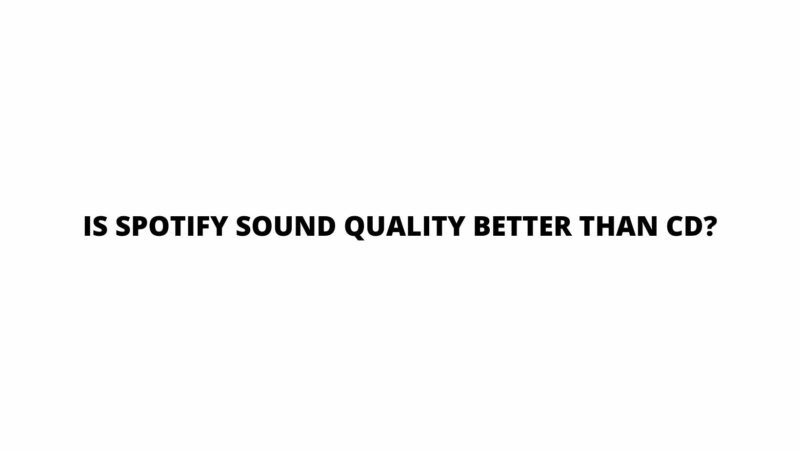In the realm of music consumption, the clash between traditional physical media and modern digital streaming services has given rise to a perennial debate: Is the sound quality of streaming platforms like Spotify truly superior to that of the venerable compact disc (CD)? As technology evolves and our listening habits shift, it’s essential to scrutinize the claims surrounding sound quality and discern whether Spotify has truly surpassed the audio fidelity of CDs. In this article, we delve into the intricacies of sound quality in both formats, exploring the factors that contribute to the audio experience and ultimately determining whether Spotify’s sound quality reigns supreme.
Understanding Sound Quality
Before diving into the comparison, let’s establish the foundations of sound quality. Audio quality comprises various elements, including dynamic range, frequency response, clarity, and spatial accuracy. The ability of a format to reproduce these elements accurately is a key determinant of its perceived sound quality.
Spotify Sound Quality
Spotify, one of the world’s most popular music streaming services, offers several levels of sound quality to cater to different preferences and internet connection speeds. The primary options are:
- Normal (96 kbps): This quality level is suitable for users with limited data plans or slower internet connections. While it provides a convenient way to listen, it sacrifices some audio detail for the sake of reduced data usage.
- High (160 kbps): The high-quality option offers improved audio fidelity with a higher bitrate. It strikes a balance between data consumption and sound quality.
- Very High (320 kbps): This option delivers the highest bitrate available on Spotify and is often touted as offering near-CD quality sound. It’s favored by audiophiles and enthusiasts who prioritize sound quality.
CD Sound Quality
Compact discs, with their uncompressed audio and high data capacity, have long been considered the gold standard for audio quality. CDs offer 16-bit audio sampled at 44.1 kHz, allowing them to capture a wide frequency range and dynamic range, resulting in a rich and detailed listening experience.
Factors Influencing Sound Quality Comparison
When comparing the sound quality of Spotify and CDs, several factors come into play:
- Bitrate and Compression: Bitrate refers to the amount of data used to represent audio per unit of time. Higher bitrates generally yield better audio quality, as more data is available to accurately represent the audio signal. CDs, being uncompressed, offer a consistently high bitrate, while Spotify’s sound quality varies based on the selected bitrate.
- Compression Algorithms: Spotify employs audio compression algorithms to reduce file sizes without sacrificing too much audio quality. While modern compression algorithms are quite effective, they inherently involve some loss of audio data, especially at lower bitrates.
- Source Material: The original source material plays a crucial role. If a recording is of subpar quality or has been heavily processed, even the best format might not be able to fully capture its potential.
- Listening Environment: The environment in which the audio is played also affects perceived sound quality. Factors like the quality of speakers or headphones, room acoustics, and ambient noise can impact the overall listening experience.
Subjective and Objective Assessment
Evaluating sound quality is inherently subjective, as different individuals might prioritize various aspects of audio fidelity. While audiophiles and music enthusiasts often engage in A/B testing to compare formats, blind listening tests reveal that even trained ears sometimes struggle to consistently identify differences between high-quality streaming and CDs.
Objective measurements, like frequency response analysis and dynamic range calculations, can provide insight into the technical aspects of sound quality. However, these measurements might not capture the full perceptual experience of sound quality, which is influenced by human perception and emotional engagement.
Choosing the Right Format for You
The choice between Spotify and CDs depends on personal preferences and priorities:
- Convenience and Accessibility: Spotify’s convenience and vast library make it an attractive choice for on-the-go listening. If convenience takes precedence, the slight differences in audio quality might not be a dealbreaker.
- Audiophile Pursuits: Audiophiles who demand the highest level of audio fidelity might still prefer CDs, as their uncompressed nature and high bitrates ensure a more accurate representation of the original recording.
- Internet Speed and Data Usage: Streaming services like Spotify require a stable internet connection. If you’re in an area with unreliable connectivity or have data usage restrictions, CDs might be a more reliable option.
Conclusion
The debate over whether Spotify’s sound quality surpasses that of CDs is a nuanced one. While Spotify’s high-quality streaming options offer impressive sound fidelity, the inherent compression involved in streaming and the pristine nature of CDs make for a challenging comparison. Objective measurements and subjective listening tests provide different perspectives, but ultimately, the choice between Spotify and CDs depends on individual priorities. Convenience, accessibility, audiophile pursuits, and personal listening environments all play a role in determining which format aligns with your preferences and values. As technology continues to advance, both formats will continue to evolve, providing listeners with ever-improving audio experiences.


